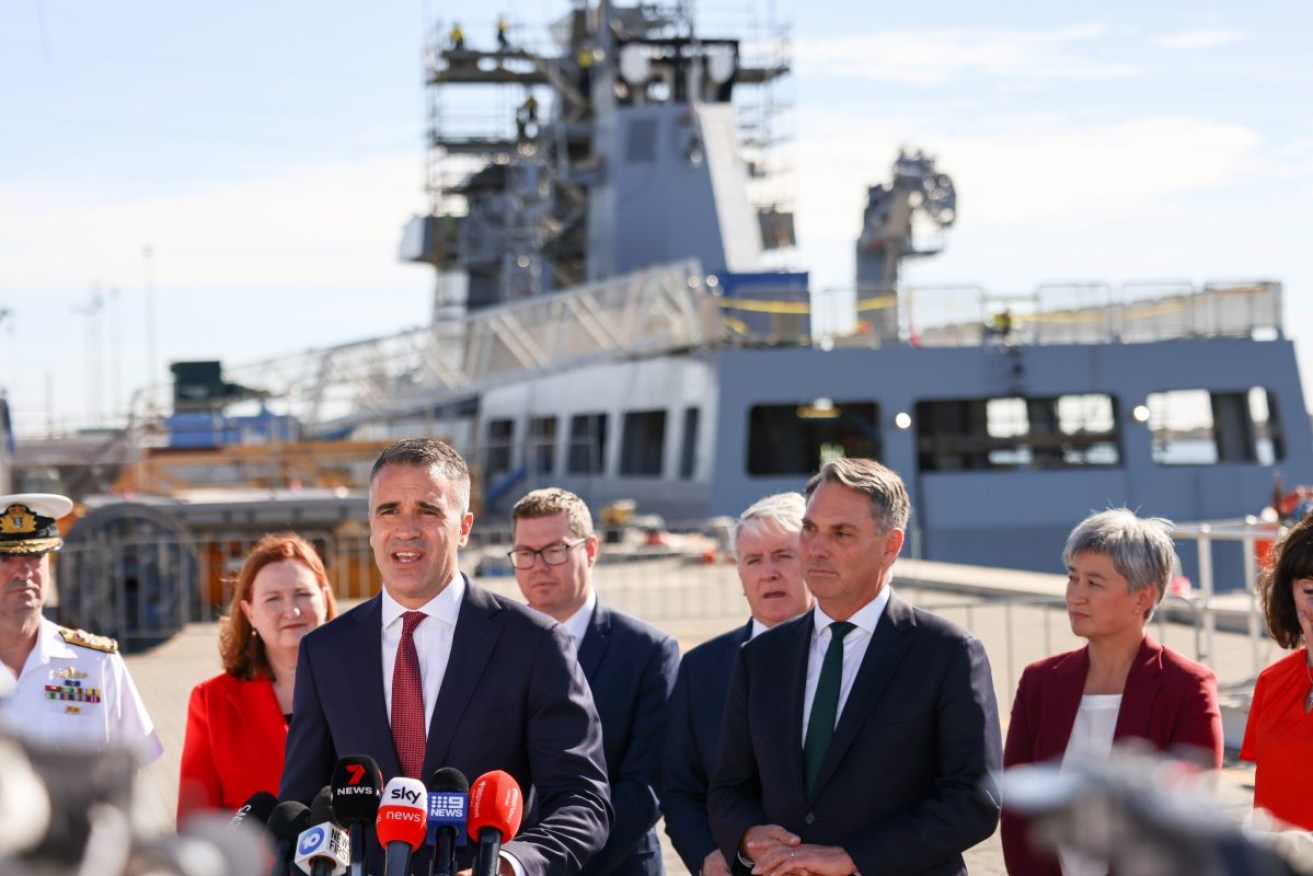Land swap and hundreds of uni places in submarine deal
The federal government will hand over Defence Department land at Adelaide’s Keswick barracks to South Australia to enable the Osborne shipyard to become the fourth nuclear-powered submarine production line, alongside those in the US and UK.

Premier Peter Malinauskas with Defence Minister Richard Marles and Foreign Minister Penny Wong at Osborne last week. Photo: Tony Lewis/InDaily
A potential exchange of Defence-owned and leased land north of Adelaide at Cultana has also been flagged for the state’s hydrogen project.
In a deal announced today, the federal government will also back an additional 800 university places in South Australia for engineers and scientists, with the first 200 places to commence in 2024.
A training academy will also be set up at Osborne to provide for apprentices and trade training.
It comes a day after the Australian, US and UK governments announced the pathway to acquiring eight nuclear-powered submarines over the next three decades in an AUKUS alliance deal worth up to $386 billion.
Australia will buy US Virginia-class submarines in the short-term to 2033 before a new SSN-AUKUS-class, conventionally-armed hybrid vessel arrives in Australian waters. Australia is not scheduled to complete the first of its own SSN-AUKUS class boats until 2042.
Defence Minister Richard Marles visited the Osborne site this morning with Premier Peter Malinauskas and said the massive endeavour has been demanded by Washington and London in order to take the strain off nuclear submarine production lines, with both nations currently at capacity.
“Developing this capability for our nation will make our nation more safe. Developing this capacity for Australia will have us be taken more seriously around the world,” Marles said.
“We have to take the step of developing the capability to operate a nuclear-powered submarine so that we can hand over a much more self-reliant nation to our children and to our grandchildren.”
The delivery of the first Australian-made nuclear submarine under the AUKUS deal isn’t scheduled until 2042, but Marles said today that “we will be cutting steel this decade”.
He said the land swap announced today marked “the beginning of construction”.
The historic Keswick Barracks is an Australian Army facility that includes a heritage-listed office building.
“(The) land exchange is going to provide South Australia with really important land at Keswick in urban Adelaide (and) land at Cultana, which is important in terms of the hydrogen project…,” Marles said.
The Cultana land, between Whyalla and Port Augusta, is the largest Defence Department training area in South Australia.
Malinauskas says the state stands ready to do whatever it takes to deliver the nation’s security needs.
“The Commonwealth sees in South Australia the ability to build the most complex machines that have ever been produced in the history of humanity.”
But the plan to dispose of nuclear waste from the submarines in the future is already becoming a point of contention.
The Australian Conservation Foundation said the government had been silent about how the nuclear material powering the submarines would eventually be disposed of.
The foundation’s nuclear analyst, Dave Sweeney, said Australia did not have the experience and expertise required to manage high-level radioactive waste.
“AUKUS presents by far the biggest threat yet that Australia will become a dumping ground for the world’s worst nuclear waste,” he said.
Marles said the submarine waste would be disposed of on Defence land and Australia had time to make sure the process was done right.
A plan outlining how the waste will be handled is set to be released this year.
“The first of the reactors that we will need to dispose of will be in the mid-2050s, so we’ve got time to prepare for this,” Marles said.
China issued a warning that the nuclear submarines were setting AUKUS on a “path of error and danger” that disregarded concerns from the international community.
Opposition defence spokesman Andrew Hastie hit back at the Chinese comments, describing them as hypocritical.
“China is, after all, undergoing the biggest peacetime military expansion since World War II, so it’s a bit ironic for them to give us a lecture about a modest increase in our military power relative to this,” he told ABC Radio.
“We certainly don’t want to create any issues with China, we just want to make sure that we will be able to defend ourselves in the future.”
– Belinda Willis with AAP




